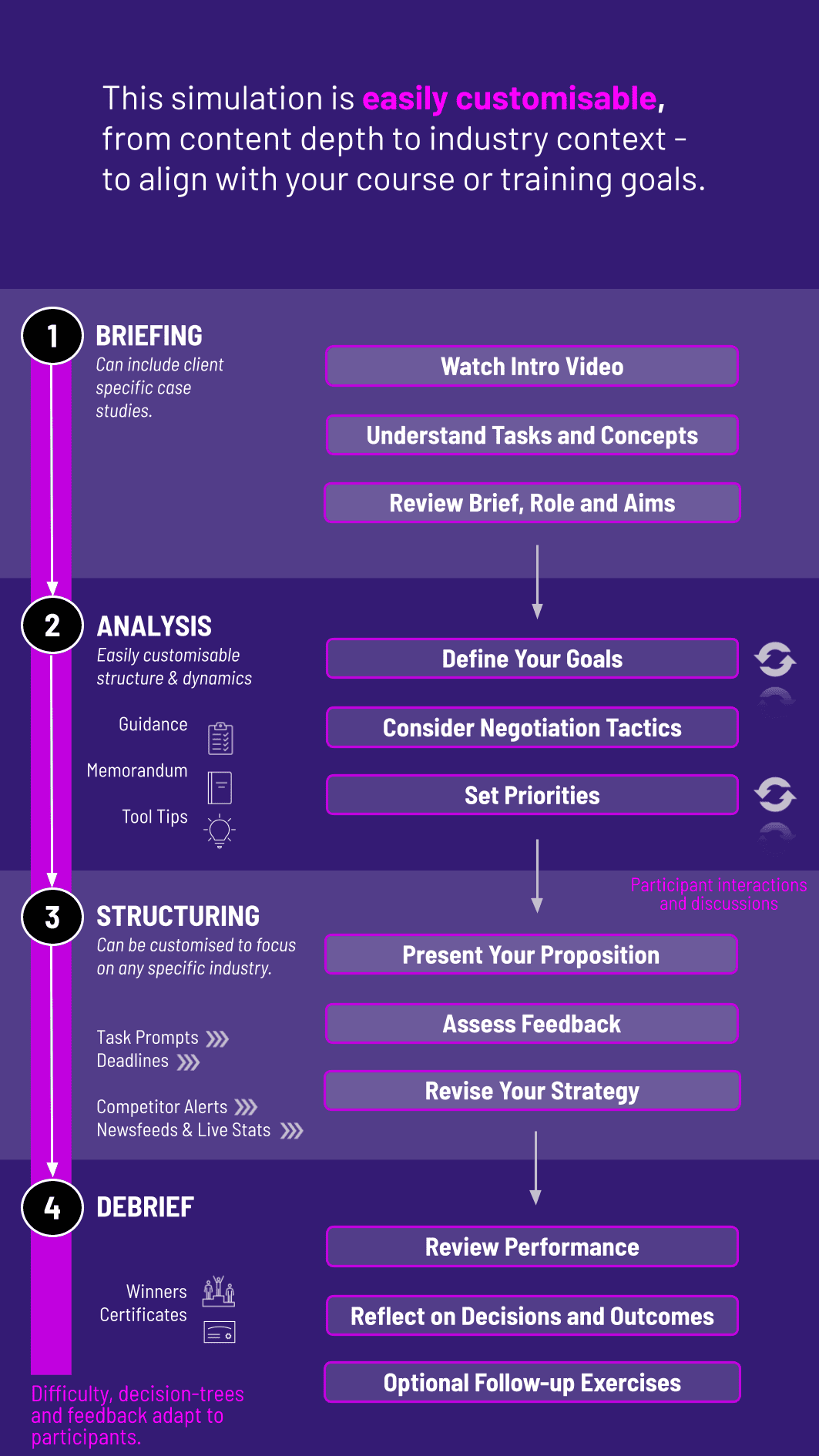
In this hands-on Boardroom Negotiation Simulation, participants act as executives and stakeholders negotiating high-stakes boardroom issues - balancing strategy, governance, ethics, and influence to achieve alignment under pressure.
Power dynamics and influence in boardrooms
Strategic negotiation and compromise
Stakeholder alignment and conflict resolution
Ethics and governance in corporate decisions
Communication and persuasion skills
CEO succession and executive accountability
M&A, divestiture, and strategic pivot decisions
Role of independent directors and investors
Short-term vs long-term shareholder interests
Reputation and trust in leadership


Take on roles as executives, directors, or investors with distinct agendas
Negotiate high-stakes strategic issues in boardroom settings
Balance governance, ethics, and shareholder priorities
Draft board memos, resolutions, or press statements
Respond to crises like activist campaigns or reputational damage
Build alliances or challenge opposing positions to influence outcomes
By the end of the simulation, participants will be able to:
Apply negotiation frameworks to board-level decisions
Manage conflicting priorities across diverse stakeholders
Demonstrate ethical leadership in high-stakes contexts
Communicate persuasively in boardroom environments
Balance governance, strategy, and shareholder expectations
Recognize the impact of trust and influence on decisions
Lead alignment around complex or contentious issues
Adapt strategy in response to new developments
Strengthen collaboration under pressure
Reflect on personal negotiation style and effectiveness
The simulation’s flexible structure ensures that these objectives can be calibrated to match the depth, duration, and focus areas of each program, whether in higher education or corporate learning.
This simulation can run individually or in teams and is suited to universities, executive programs, or corporate leadership workshops. Each round mirrors a phase of boardroom decision-making.
1. Receive a Scenario or Brief: Participants receive a board-level challenge, such as an acquisition proposal, CEO transition, or governance crisis, with clear objectives and roles.
2. Analyse the Situation: They review financials, stakeholder briefs, and governance implications, assessing risks and opportunities.
3. Negotiate in the Boardroom: Participants present positions, debate trade-offs, and negotiate toward resolutions—balancing influence, compromise, and persuasion.
4. Collaborate or Compete: Depending on role, participants may form alliances, challenge peers, or advocate for particular stakeholder interests.
5. Communicate Decisions: Teams draft resolutions, board statements, or external communications reflecting the negotiated outcome.
6. Review and Iterate: Feedback reveals impacts on strategy, governance score, and stakeholder trust. Subsequent rounds introduce new crises or shifts requiring adaptation.
Do participants need boardroom experience? No. The simulation is accessible for all levels, with context provided for each role.
Can it be tailored for specific industries? Yes. Scenarios can be customized for finance, energy, tech, or consumer sectors.
Does it include ethics and governance dilemmas? Yes. Ethical trade-offs are built into board decisions and stakeholder dynamics.
**Is there a negotiation component? Absolutely. Negotiation and persuasion are central to the gameplay.
Can participants work in teams? Yes. Teams or individuals can play roles such as executives, independent directors, or investors.
How long does it take? It can run in 2-hour workshops, multi-day courses, or semester-long modules.
Is the simulation online-compatible? Yes. It works in digital, in-person, or hybrid formats.
How is success measured? By governance scores, stakeholder trust, and strategic alignment in decisions.
Can universities use it for corporate governance courses? Yes. It’s a strong fit for MBA, executive education, and governance programs.
Does it include crisis response? Yes. Rounds can feature activist campaigns, reputational risks, or shareholder revolts.
Effectiveness in negotiation and alignment
Ethical reasoning and governance insight
Communication clarity and persuasion under pressure
Responsiveness to evolving dynamics
Peer/self-assessments on collaboration and influence
You can also include memo writing and debrief presentations as part of the assessment structure. This flexibility allows the simulation to be easily integrated by professors as graded courses at universities and by HR at assessment centres at companies.
Join this 20-minute webinar, followed by a Q&A session, to immerse yourself in the simulation.
or
Book a 15-minute Zoom demo with one of our experts to explore how the simulation can benefit you.